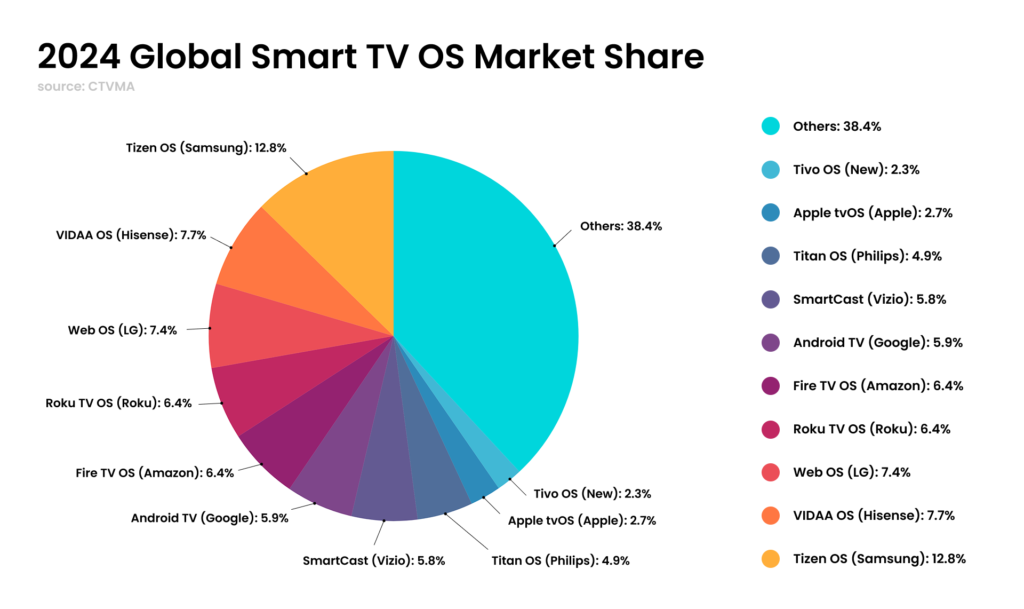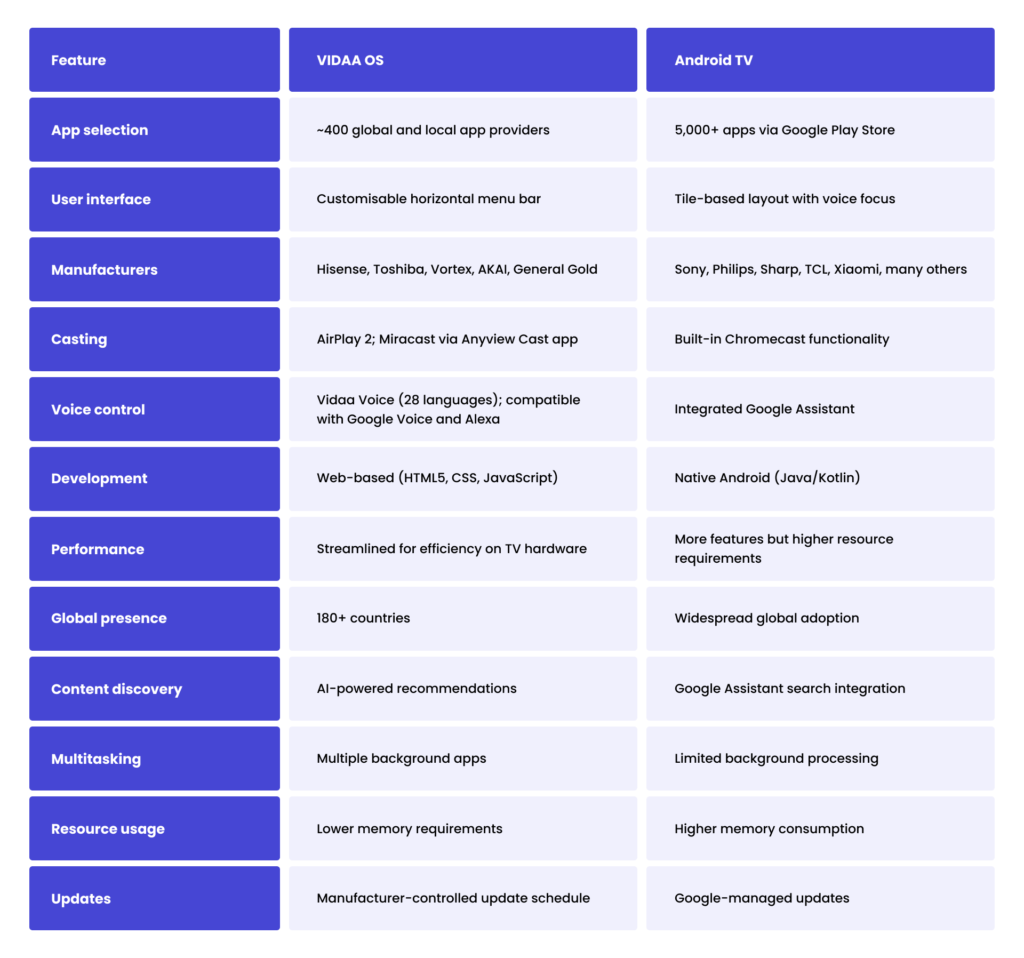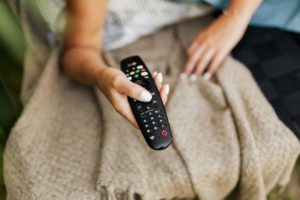What is VIDAA OS? A comprehensive guide to your smart TV experience
For media companies and content creators looking to expand their reach, the smart TV landscape offers surprising opportunities beyond Android TV. VIDAA OS has quietly emerged as a significant player, capturing 7.7% of the global Smart TV market in 2024, substantially outperforming Google’s Android TV, which captured 5.9%.
This shift reveals changing consumer preferences as VIDAA’s streamlined, TV-focused approach challenges the conventional wisdom that more apps and features automatically win the day. Built specifically for the lean-back experience, this rising platform has found its growing audience through simplicity and performance rather than complexity.
For developers, VIDAA offers a compelling balance between reach and visibility. Its web-based development approach using familiar technologies lowers the barrier to entry, while its less saturated marketplace provides greater opportunity for discovery than Android’s crowded ecosystem. The platform’s efficient resource management ensures consistent performance even on mid-range TV hardware.
In this article, you’ll discover what makes VIDAA OS a compelling platform for content creators, including its web-based development environment, streamlined user experience, and growing global footprint.
Whether you’re building your first smart TV application or expanding an existing streaming service, understanding VIDAA’s unique approach to television will help you leverage its strengths for connecting with audiences in their living rooms.

What is VIDAA OS?
VIDAA OS is a Linux-based operating system specifically designed for smart TVs. It offers a streamlined alternative to more complex platforms like Android TV. Developed primarily for Hisense Smart TV models and other select TV manufacturers, this specialised TV OS prioritises speed, simplicity, and a seamless viewing experience.
VIDAA OS offers exceptional performance optimisation as a purpose-built television solution while delivering a secure, lean-back experience across various TV models.
With availability in over 180 countries and powering over 2.1 billion hours of watched content monthly, VIDAA OS has established itself as a significant player in the smart TV platforms landscape without the extensive resource requirements of some competing systems.
How does VIDAA OS work?
VIDAA OS operates through a Linux-based architecture specifically optimised for television hardware. Unlike more complex operating systems like Android TV, it follows a similar technical approach to Tizen OS or Titan OS, using a lightweight core system that prioritises efficiency.
When you power on your TV, the system initialises through a multi-stage boot process, loading only essential system components first to minimise startup time. The kernel manages hardware resources, allocating processing power and memory to different functions based on immediate needs.
Once operational, VIDAA OS establishes network connections through your internet router, enabling content streaming while simultaneously monitoring for connected devices via Bluetooth, Wi-Fi Direct, or through your home network. This connection management happens in the background, continuously optimising bandwidth allocation based on current activities.
The system’s architecture separates the application layer from the core OS functions, allowing apps to run in isolated environments. This creates a security boundary between different applications, enabling the system to manage resources efficiently. For example, when you launch Netflix or another streaming service, the OS allocates only necessary resources to that application while maintaining system responsiveness.
For voice control functionality, audio input is pre-processed on-device before being sent to recognition servers (when connected to the internet) or processed locally for basic commands. The system then interprets these commands and executes the corresponding actions through control interfaces.
The VIDAA OS monitors system performance and user activity, dynamically adjusting resource allocation to maintain a responsive experience. This approach allows it to deliver a consistent viewing experience across different TV models with varying hardware capabilities.
Key features of VIDAA OS
For media companies looking to expand their reach through smart TV platforms, understanding the features of VIDAA OS is essential for an effective distribution strategy. Here’s what makes this operating system particularly relevant for content providers:
Content distribution platform
The VIDAA Operating System is a central content hub pre-installed on all Hisense Smart TV models and other manufacturers’ TV models. It connects viewers with diverse entertainment options, making it a valuable distribution channel for established and emerging content creators. Media companies can reach audiences through this platform alongside primary services like Netflix, Disney+, Amazon Prime, and YouTube.
Streamlined user experience
VIDAA Smart TV OS prioritises a straightforward, fast, and secure lean-back experience – critical factors for maintaining viewer engagement with your content. The system’s responsive design minimises friction between viewers and content, potentially reducing abandonment rates compared to more complex operating systems.
Customisation features
Users can personalise their experience through features like Customisable Screensaver, where they can upload their own images to their VIDAA account. The Launcher Bar allows seamless navigation through frequently used apps, ensuring effortless access to preferred content.
Integrated content discovery
This smart TV operating system offers a comprehensive video hub that combines FAST TV channels, Live TV, and on-demand content in a unified interface. For content providers, this integration means your offerings can be discovered through multiple pathways rather than being siloed within a single app ecosystem.
Voice interaction capabilities
With voice control support for 28 languages, VIDAA allows viewers to find and access content through natural voice commands. This feature reduces navigation barriers and can increase content discoverability, which is particularly important for non-English content or in markets where text-based search is less preferred.
Mobile companion app
The VIDAA mobile app extends the platform’s capabilities, providing viewers with alternative control options and potentially deeper engagement with global and local content. This secondary screen experience offers additional touchpoints for audience interaction beyond the TV screen itself.
Audience segmentation features
VIDAA Kids offers family-friendly content in a protected environment with parental controls for managing viewing habits. For producers of children’s programming, this segregated content area provides a more appropriate context for discovery and viewing.
Global reach potential
Available in over 180 countries and powering devices from manufacturers like Hisense, Toshiba, and numerous regional brands, VIDAA TV OS offers significant international distribution potential. This smart TV operating system currently facilitates over 2.1 billion hours of global and local content watched monthly, indicating substantial active usage.
Growing app ecosystem
The platform currently hosts more than 400 global and local applications and continuously expands. This represents a less saturated environment for content providers than some competing smart TV platforms, potentially offering better visibility than in more crowded marketplaces.
Advertising opportunities
Due to its popularity, VIDAA OS offers significant marketing potential for brands looking to reach audiences in their homes. The platform features a prominent banner area at the top of its user interface where marketing materials can be positioned for maximum visibility. In South Africa alone, the VIDAA banner achieves over 2 million impressions per week, providing considerable exposure for advertisers.
Want to reach millions of new viewers through VIDAA OS?
Learn moreVIDAA OS vs Android TV: key differences
When choosing a smart TV or evaluating TV operating systems, it’s essential to understand the distinctions between platforms. VIDAA OS, developed primarily for Hisense Smart TVs, takes a different approach to the viewing experience than the more widely known Android TV system.
While both platforms aim to deliver seamless access to streaming services and entertainment, they differ significantly in their design philosophy, functionality, and target markets. Here’s how these two TV operating systems compare across key dimensions:
- App ecosystem: VIDAA OS offers access to over 400 global and local application providers, focusing on quality entertainment options. Android TV provides access to the Google Play Store, which offers more than 5,000 applications across various categories, giving users substantially more options for niche applications.
- User interface: VIDAA OS features a customisable menu bar at the top of the display, allowing users to quickly switch between background applications without leaving the current setting. Android TV employs a more complex tile-based interface with voice-activated searching as the primary navigation method, which may feel more familiar to smartphone users.
- Casting capabilities: VIDAA OS supports AirPlay 2 but has a somewhat cumbersome Miracast implementation requiring the Anyview Cast app. Android TV has built-in Chromecast functionality, allowing seamless casting from mobile devices to the TV without additional setup.
- Device availability: VIDAA OS powers TV models from Hisense and Toshiba, as well as select manufacturers like Vortex, Schneider, AKAI, and General Gold. Android TV is implemented by numerous global manufacturers, including Sony, Philips, Sharp, TCL, and Xiaomi, offering a greater variety of hardware and price points.
- Performance optimisation: VIDAA OS prioritises efficiency with a streamlined operating system focusing on performance, usability, and cost-effectiveness. Android TV offers more flexibility and customisation but tends to be more resource-intensive, which may impact performance on lower-end hardware.
- Voice control: VIDAA OS supports voice commands in 28 languages and is compatible with Google Voice and Alexa. Android TV features comprehensive Google Assistant integration, making voice control a central feature of the platform’s navigation experience.
- Development approach: VIDAA OS employs a web-based development model using HTML5, CSS, and JavaScript within a Chromium-based environment, making it accessible for web developers. Android TV requires native Android app development using Java or Kotlin, which typically involves a steeper learning curve.
- Global reach: VIDAA OS is available in over 180 countries, and users consume more than 2.1 billion hours of content monthly. Android TV maintains broader global adoption across multiple major manufacturers, giving it a larger market footprint overall.

How does VIDAA OS app development work?
VIDAA OS makes creating TV apps surprisingly accessible by using familiar web technologies that many developers already know. Think of it as building a website, but one specifically designed to work perfectly on your TV screen.
Here’s how it works in simpler terms:
- Developers create TV apps using the same tools they use for websites (HTML, CSS, and JavaScript)
- The TV runs a special browser (based on Chrome) that displays these web apps as full-screen experiences
- Unlike websites, these apps are designed specifically for remote control navigation rather than mouse clicks
- Developers must ensure their apps run smoothly with the TV’s limited processing power (TVs aren’t as powerful as computers)
Creating a VIDAA app involves:
- Building a user interface that’s easy to navigate with just the up, down, left, right, and OK buttons on your remote
- Ensuring text is large enough to read from across the room (your couch)
- Optimising images and videos so they load quickly and play smoothly
- Including an easy way to exit the app using the Back button
Testing is straightforward. Developers can install test versions of their apps directly on compatible TVs using a special debug mode. This lets them see exactly how their app looks and performs in the real world.
The platform supports all the features you’d expect from a modern streaming app, including various video formats, streaming technologies, and content protection systems to deliver secure, high-quality entertainment.
Once an app is ready, it goes through VIDAA’s certification process before being made available to millions of users worldwide through the VIDAA platform on Hisense Smart TVs and other compatible devices.
Unlock new audiences with VIDAA OS
VIDAA OS represents an untapped opportunity for content providers seeking growth. This platform’s rising popularity across Hisense, Toshiba, and partner manufacturers opens doors to millions of engaged viewers worldwide.
At Spyrosoft BSG, we transform complex TV development challenges into streamlined solutions. Our specialised team navigates VIDAA’s web-based architecture and certification requirements, delivering applications that perform flawlessly while maximising content discovery in this less crowded marketplace.
Explore how we can collaborate to build your VIDAA presence and create compelling experiences that stand out on the biggest screen in the house.
About the author
Contact us





![[thumbnail] media and entertainment - VOD vs OTT_ what is the difference](https://spyro-soft.com/wp-content/uploads/2025/04/thumbnail-media-and-entertainment-vod-vs-ott_-what-is-the-difference-min-1024x655.jpg)